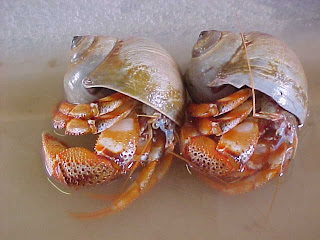Fisherman's Bucket
Hermits, hermits, hermits!
Yesterday a local fisherman, Mike brought us in a pile of goodies fresh off his sea urchin drag boat. The weather had finally warmed up and the seas subsided enough for him to go out safely and try to make his living.
Besides the sea stars he brought in, I had asked him to keep an eye out for some hermit crabs and other small invertebrates. The hermits were HUGE - mostly flat - clawed variety, but there were some hairy hermits as well. Some of them were a bit stressed due to the anoxic conditions in the small pail and they had exited their shells. This was a bit concerning, at first - I wondered how they would do outside their shells. I placed them into my tank 'naked' for the evening and when I returned in the morning, they had all found suitable shells to move back into... 'shall I slip into something a bit more comfortable...?'.
The catch
To my surprise, many of the hermits were egg-laden (gravid, berried?). You wouldn't be able to see this unless they had come out of their shells. The eggs look just like a lobster's egg mass. The color was very black and the eggs a bit smaller though.
Hermit crab party.
Hairy hermit crab in my hand.
Hairy hermit crab with eggs (berried).
Flat clawed hermits.
Hermit crabs are one of the easier marine invertebrates to take care of in a tank. I feed mine bits of clam or squid when I have it. They will all gather around a lump of feed like cows at a trough, snipping and tearing bits to feed into their mouths. It is pretty neat to watch. As for the shell species that were represented - there were all the major mollusc snails we have here in Cobscook Bay. Waved whelk shells, moon snail shells, Stimpson's Coleus shells, and dogwinkle shells. The moon snail shells are the most impressive. Since these snails get very large, the Hermits that inhabit them are big too.
Sea grapes.
Sea peaches.
Toad crab.
Sea vase.
As for other species that came up in the fisherman's trawl, we found tunicates, other crabs, and worms. There were several toad crabs, Hyas genus. The largest of these was about 8" across. The sea squirts in the pail were Sea Grapes (Molgula), Sea Vase (Ciona), Sea Potatoes (Boltenia), and Sea Peaches (Halocynthia). All of these were cemented to other tunicates in clusters or they attach to mussels, rocks, and other debris. Final inspection of the pail's contents revealed some fan worms, finger sponge, scaleworms and some tiny isopods - benthic creatures that had come up in the holdfasts of the tunicates and sponge. I dumped the remainder in our tanks. Hopefully, they will adapt to the smaller quarters and find their niche - it's a crab eat, worm eat, snail world in there!
Tidepool Tim








